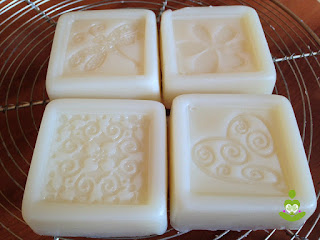Over the last two years, I have reached a point where I make most of my family's personal care and household products at home. The skin is the largest organ of the body and considering it can absorb more than 50% of what it comes in contact with, knowing exactly what you are putting on your skin just makes sense.
Most commercial lotions contain ingredients that are drying to the skin (and make you use more product), are made with potentially harmful ingredients and can come with warnings to call Poison Control in case it is swallowed.
I have become pretty diligent when it comes to reading all labels, whether they are on food or makeup or personal care products. And as a general rule, if I do not know what something is, I do not want it in, on or around our bodies.
Lotion marketed for babies sounds like it would be your best bet for a soothing skin care product. I mean, it is marketed specifically for babies with new skin, so it should at least be safe to use, right? Below, is the list of ingredients for a bottle of baby lotion by Aveeno:
 |
| Aveeno Baby Soothing Relief Moisture Cream |
GLYCERIN: listed after water, is a humectant.
PETROLATUM: is a mixture that comes from petroleum (which is used to produce fuels such as gasoline, kerosene and diesel).
MINERAL OIL: another version of petrolatum. Baby oil is a fancy name for perfumed mineral oil.
CARBOMER: used as an emulsifier that is made up of acrylic acid monomers.
DIMETHICONE: a silicone-based polymer. Silicone is a synthetic rubber and synthetic plastic hybrid.
CETEARETH-6: is a glycol ether of cetearyl alcohol.
METHYLPARABEN: part of the paraben family of preservatives used by the food and drug industries. Parabens are harmful because they can mimic estrogen and disrupt hormones.
SODIUM CITRATE: a form of citric acid, can be found in citric fruits/juices.
TETRASODIUM EDTA: used as a chelating agent to reduce reactivity of metal ions present in the product.
BENZALKONIUM CHLORIDE: used as a disinfectant, antiseptic and detergent. Repeated use can lead to a development of resistant bacteria. It is associated with severe skin, eye and respiratory irritation and allergies and harmful to those with eczema and asthma.
PROPYLPARABEN: another chemical that disrupts hormones.
ETHYLPARABEN: another hormone disrupter.
PEG-25: a glycol ether of stearyl alcohol.
SOY STEROL: phytosterols made from soy and used as an emollient.
BENZALDEHYDE: used as flavoring or aromatic agent and is toxic.
HYDROLYZED OATS: used as skin and hair conditioning agents.
BUTYLENE GLYCOL: used both as a solvent and conditioning agent and is irritating to the skin, eyes and lungs.
None of the ingredients above sound especially safe for an adult, let a alone a baby with new skin! And note to vegans and vegetarians: glycerin and stearyl alcohol may be derived from animals.
Now, you can find a lot of homemade lotion recipes and instructions but I tend to make very simple ones. I normally do not have the patience for complicated recipes that require a lot of mixing or a lot of ingredients. When I make a personal care product, I want it to work well and I like to use ingredients that I normally have on hand.
Lotion bars are great because they are not messy and are easy for children to use. Since they are also easy to make into cute shapes using different molds, they also make great gifts. And with these bars, it feels good knowing that unnecessary, disruptive and damaging chemicals on our skin are being avoided.
Easy DIY Lotion Bars
- 2/3 cup beeswax pastilles
- 1/2 cup organic coconut oil
- 1/2 cup cocoa or shea butter*
- 2 tablespoons organic olive oil
- 10-20 drops essential oils, such as orange or lemongrass - or a combination (optional)
Combine all ingredients, except for the essential oils, in a glass mason jar. Set the jar in a small saucepan that has 2 inches of water (careful not to get any water into the mason jar). Warm the pan over low heat until all of the ingredients in the mason jar are melted and stirred well. Remove the mason jar from the pan and let it cool for about 10 minutes before adding the essential oils. Carefully pour the mixture into a silicone mold and allow the bars to harden for 4 hours before unmolding.
*The cocoa butter can be replaced with mango butter.

Comments
Post a Comment